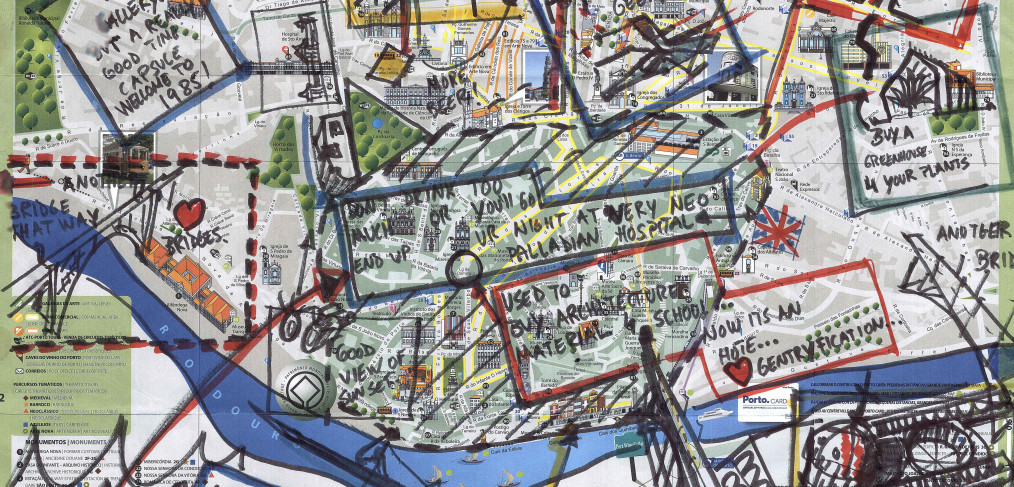
Porto like the back of your hand
The map of Porto inside a tourist’s backpack was for free at a tourist information office and it has travelled all over the city. Some hours spent at the old center, inside the medieval walls, a lunch and beer break at the downtown riverside, Porto Wine tasting at the wine cellars in Gaia, some shopping in Santa Catarina street, night out at Aliados and Galerias de Paris and, of course, for the “architourists”, some Siza and Souto de Moura buildings, and maybe even some Koolhaas.
It’s an old map with wrinkled corners… Too many walks down the same streets, same sightseeing sites, same monuments and landmarks, same postcards. A map of Porto that we know by heart.
The city stands always in the same site because it’s foundations are stone and concrete. But that doesn’t mean that our young feet can’t go around in a bit more daring way.
Just because it’s not an avenue, doesn’t mean you can’t walk it.
Just because there’s no door, doesn’t mean you can’t get in.
Just because there’s no staircase, doesn’t mean you can’t climb it.
Another map of Porto (this time from the XIXth century) shows a few streets that stand out: Rua D. Manuel II, Rua de Cedofeita, Rua do Almada, Rua de Santa Catarina, Rua Santo Ildefonso and, of course, the medieval city inside the walls. Designed lengthwise from the medieval center, the connections between them were left to be filled later. The important thing was to expand North, since the medieval center was already really dense.
From the expansion processes of the medieval city, the gaps between these axes started to be filled with perpendicular streets, which allowed for the settlement of houses and then led to the creation of entire blocks. These blocks started to enclose the space around what once were fields and forests. Some of them were transformed into gardens inside the properties owned by the bourgeoisie, others into small housing “neighborhoods” for industrial workers (the so called “ilhas do Porto” – “islands of Porto”). Later, in the XXth century, they started to give way to parking lots, commerce galleries and shopping malls of all kinds.
Nowadays, the value of these in-between street spaces is often unclear: are they public or are they private? Can I go in or should I stay out? It’s the perfect hiding place for a part of the city that wants to surprise you. Therefore, to find these spaces is also to deviate from your routine trajectory and allow yourself to go just a bit further down that narrow street.
After forgetting his old map of Porto at home, a clever tourist might search for different and more exciting sights. A clever walker can take advantage of this inner-block morphology to create alternative paths – shortcuts! If one is so inclined, the city can truly be his oyster!
Through this bold movement of defying the known city, the pedestrian/tourist proves that there’s not only the city designed by architects and urban planners but also an alternate “perpendicular” city created by these private interventions.
This also makes us wonder if it could be possible to explore the entire city using these hidden paths, galleries and buildings…
Given the sad reality that this pedestrian/tourist is merely fictional, we decided to put this idea to the test for him. We went from popular malls to less popular ones, almost abandoned commerce galleries, parking lots, etc… At the end of the day we had outlined a sort of alternate map with our bare feet and instinct. We became tourists in our own city.
It took just a few meters after the starting point to realize it wasn’t so hard to find a public place we didn’t know about. And guess what? Someone already got there first… As it turns out, the unclearness of these spaces, and also their seclusion from the main points of interest, allow the manifestation of the sort of specificity you can only find in dense cities: it’s there that some urban tribes find their own place for expression. Although completely public, they don’t share the same popularity of actual streets or squares in the city, but might gain exactly the same significance, for a specific niche.
In this kind of tourism, more than getting dazzled by the good old charms of Porto, we want to be surprised by a city we didn’t know. And, for some strange reason we can’t explain, we often let the odd, the strange, the uninviting and the ugly guide us. Even old buildings we know so well by their placement in the urban structure manage to surprise us. How often do you go for a walk in a parking lot?
Travelling with no expectations makes discovery a lot more fun!
Do we really know our cities like the back of our hand…?
Author: Rotating Editor Porto










































